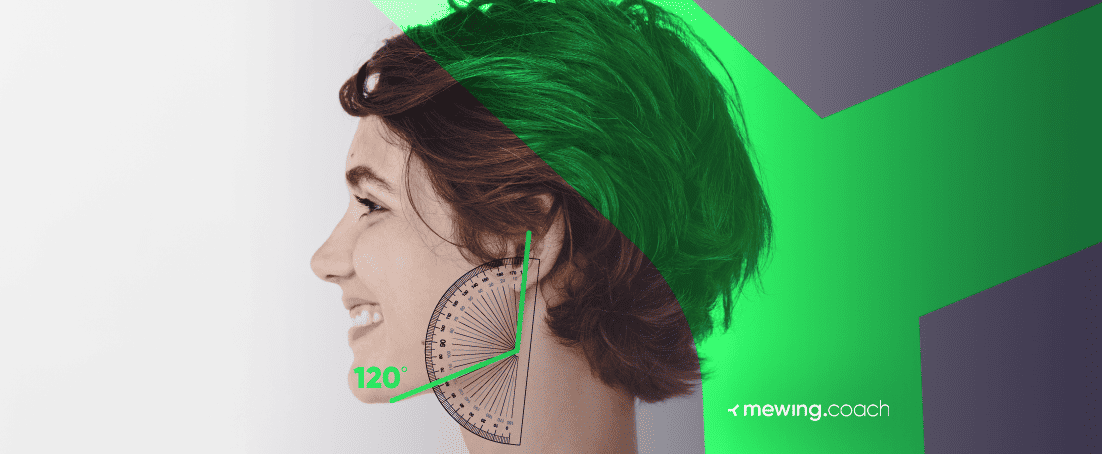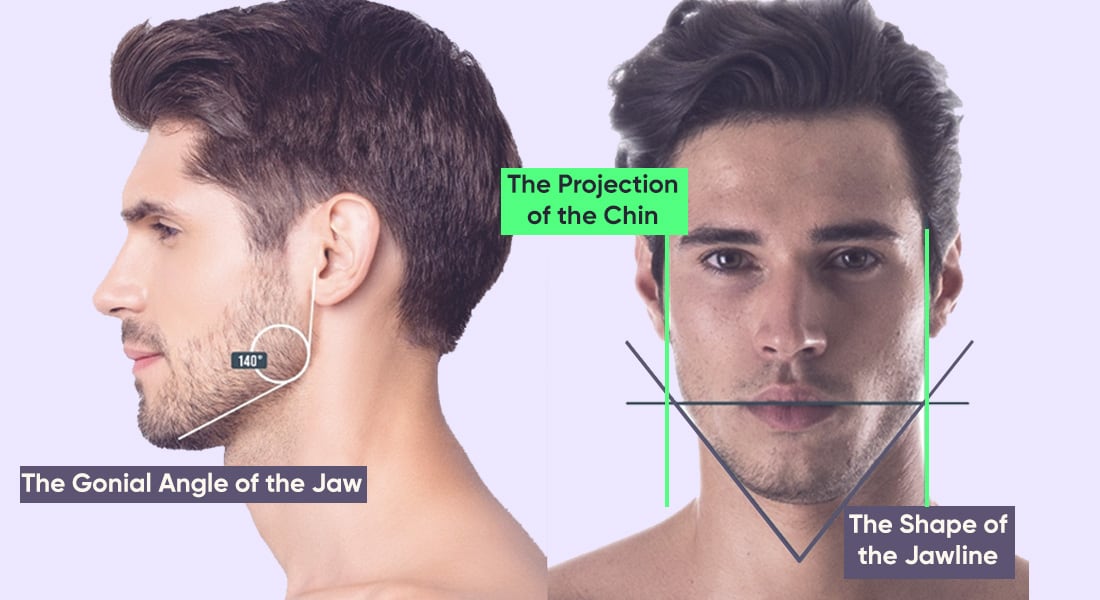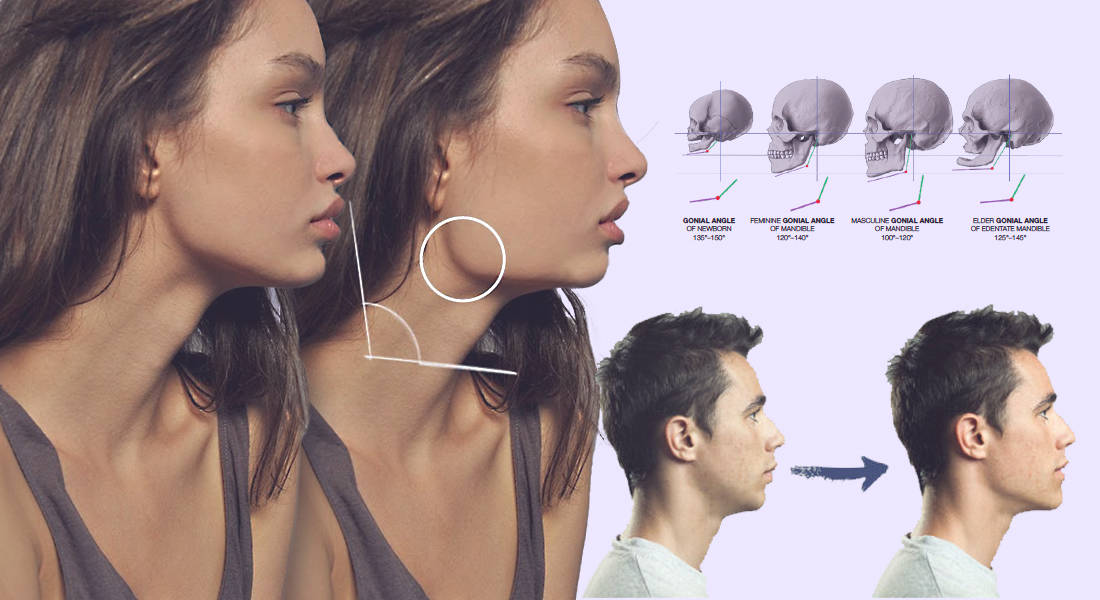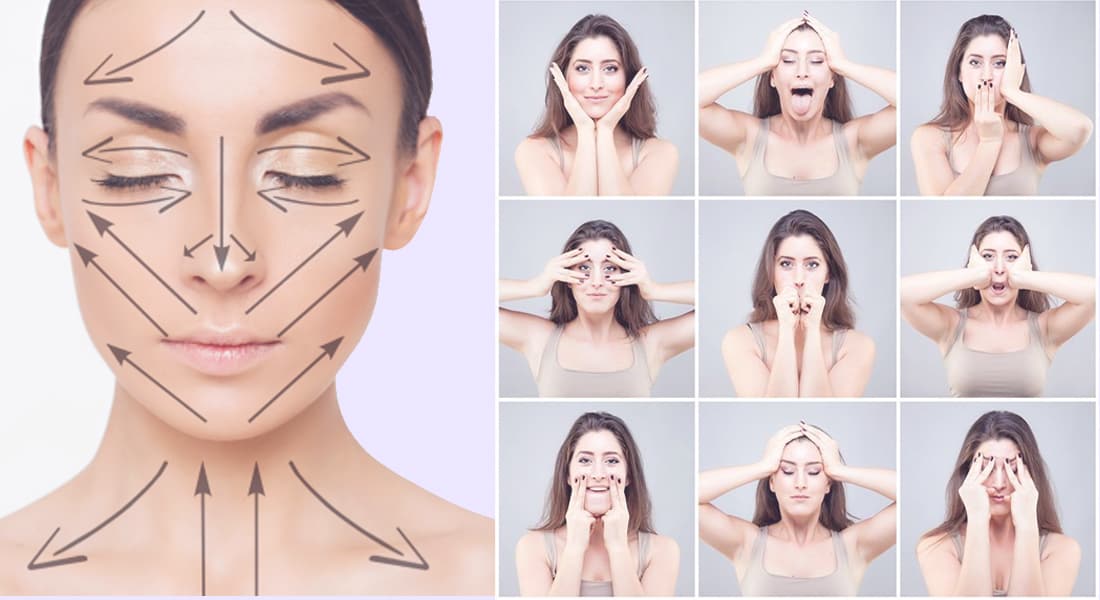
The jaw is one of the most prominent features on a person’s face. Have you ever noticed that you probably find people with stronger jawlines more attractive? There are scientific reasons for that, and they go beyond mere aesthetics.
The right name for the chiseled jaw is called gonial angle. Luckily, there are natural ways to achieve the ideal jawline.
If you’re interested to learn more about how face exercises can help you achieve a chiseled jaw, take a quick quiz below.
Here’s what else you can read in this article:
- 🔎 What the gonial angle is
- 📝 What’s the ideal gonial angle for men and women
- 📖 How many types of jawlines exist
- 🤔 How jawline shapes are different than face shapes
- 🧐 Is it possible to alter your gonial angle and change your jaw’s appearance?
Without further ado, let’s get right to it!
Gonial Angle: What Is It?
A gonial angle, a mandible angle, or a jaw angle, more commonly referred to just as jawline, is the angle formed between the ramus and the mandibular body. The ramus is the posterior border of the jawline stretching downward from the ear, and the mandibular body is the lower border of the jawline connecting the ramus and the chin. The point where the ramus and the mandible body meet is called the gonion, hence the name – gonial angle.
Regarding the good and bad gonial angles, the ramus height has a lot to do with this. When the ramus is shorter, it creates a wider angle of the mandible, resulting in a rounder face which is generally associated with a more feminine look. On the other hand, when the ramus stretches further down, the mandibular angle is more acute, resulting in a more masculine appearance.
Do Beauty Standards & Biology Have a Say?
Literature reveals diverse interpretations when in regard to beauty standards in different nationalities and regions. Gender determination also plays a big factor. The perfect male jawline is 130 degrees, although, in reality, it typically varies between 100 and 140 degrees.
And, in spite of what we said that femininity is associated with a more obtuse mandibular angle, the perfect jawline angle for women in fashion and the beauty industry is somewhere between 120 and 130 degrees. This shows that both men and women are considered to be more attractive if they have a smaller jaw angle and sharp jawline.
However, there is a biological reason behind this attractiveness, and it goes back to our primal instincts. People, particularly men, who have stronger jaws and masticatory muscles are perceived as stronger in general and are more likely to have higher testosterone levels, which is why women are biologically conditioned to find them more attractive.
The 3 Main Jawline Classification Criteria

Three main classification criteria can be used to determine what kind of jawline a person has. Different types of jawlines can be identified by:
- The Gonial Angle of the Jaw
- The Projection of the Chin
- The Shape of the Jawline
1. The Gonial Angle of the Jaws and Masticatory Muscles
The first criterion for jawline classification is the gonial angle of the jaws and the masticatory muscles. Depending on the size of the gonial angle and the development of the muscle mass of the masticatory or chewing muscles, there are three different jaw types.
Grade C Gonial Angle – The Round Angle Formed
This type is characterized by a posterior inferior angle region that creates a round face shape look. When viewed from the side, the size of the gonial angle seems very wide, and it almost looks as if the mandible body stretches all the way from the ear to the chin.
Of course, this is not true – the ramus is present, it is just less noticeable. People with this kind of jawline typically have a long and narrow face and more feminine features. Less muscle mass can also attribute to this look.
Grade B Gonial Angle – A Noticeably Defined Jawline Angle
A grade B gonial angle is distinguished by a longer ramus height and an obtuse but not excessively wide angle of the jaw. This type of gonial angle is usually close to the ideal jawline parameters, resulting in a well-shaped and prominent face.
Grade A Gonial Angle – Perfectly Square Shaped Jawline Angle
The last mandibular angle type is the grade A gonial angle which gives the jaw a perfectly square-shaped look – almost a 90-degree jawline. This type of jaw shape is very rare and bordering on the extreme.
People who have it tend to have square-looking faces and a particularly masculine appearance. This is why this type of gonial angle is more prominent in men, and women with it tend to undertake jaw reduction surgery.
We also have separate guide on how to reduce square jaw naturally.
2. The Projection of the Chin
The second criterion for jawline classification is the projection of the chin. Some people have a very prominent chin, others have a weak one. There are three main types of jawline depending on the extent to which the chin projects.
Grade C – The Chin is Receding and Not Reaching the Projection
The grade C type is known as a receding chin and occurs as a result of poor facial development when the upper jaw and the mandible are not properly aligned. The chin of people with this kind of jawline typically doesn’t align with their upper lips and jaw and instead slopes back toward the neck.
Grade B – Chin Extends to the Projection
The second type is a chin that extends to the projection of the upper lip. It is a sign of good facial development and proper facial alignment. People with this chin type typically have aesthetically pleasing features and attractive faces.
Grade A – When the Chin Extends Beyond the Projection
The last one is grade A chin projection – when the chin extends beyond the upper lip. This type of jawline is rare and, in some cases, can be a sign of abnormal facial growth.
3. Jawline Shapes
The third jawline classification is according to the shape of the jawline. Judging by appearance, there are three different jawline shapes:
Flat – a Straight Jawline
The first one is a flat, straight, or steep jawline. It typically occurs in people who have a grade C gonial angle. When turned to their profile, these people seem to have an almost straight line going all the way from their ears to their chin. It’s common in people with a long and narrow face and sometimes accompanied by a (grade C) receded chin.
Round and Soft Shaped Jaw
The second jawline shape is a round and soft jawline. It is characterized by a very obtuse gonial angle and a short, barely noticeable ramus. This convex-shaped jawline is more typical and preferred in women than in men.
Concave Jawline Shape
The last jawline shape is a concave jawline. It is characterized by a noticeably defined gonial angle and a near-perfect chin projection. Although it is mostly considered masculine because of its prominence, the concave jawline shape is attractive in men and women alike.
The Difference Between Jawline Types and Shapes & Face Shapes

People often tend to mix the terms jawline shape and face shape and use them interchangeably. However, face shapes and jawline shapes are not the same things, and although they influence each other, they don’t always have to align.
The shape and type of the jawline are mainly determined by looking at the profile view of the face, whereas the face shape is the silhouette of the front of the face. Some people have short and broad faces, while others have long and narrow ones. Some have a soft jawline, and others have a sharp one. The gonial angle makes a big difference when it comes to face shapes.
Let’s look over the nine typical face shapes and define their features.
Oblong Face Shape
People with this face shape typically have a long and narrow facial bone structure. They may have a wide forehead and a grade C gonial angle.
Rectangle Face Shape
The rectangle face shape, as the name suggests, is shaped like a rectangle. The face is longer than it is wider, and the forehead, cheekbones, and jaw look equally apart. This face shape usually comes with a concave jawline and a grade A or grade B gonial angle.
Round Face Shape
A round face is characterized by equal length and width, rounded chin, jawline, and forehead. This face shape usually has a grade C gonial angle, a round and soft-shaped jaw, and grade C or grade B chin projection and is generally symmetrical.
Square Face Shape
Similarly to the round face shape, the left and right sides of the square face are usually symmetrical. The length and width of the face are the same, and the hairline is straight.
People who have this type of face usually have a sharp jawline and accentuated cheekbones. It’s typically accompanied by a concave jawline shape and a grade A or grade B gonial angle.
Inverted Triangle Face Shape
This face shape is known for its narrow jawline and pointed chin. The face is usually longer than wider, and it has a big wide forehead. People who have this face shape typically have a flat jawline and grade A or grade B chin projection.
Heart Shaped Face
The heart-shaped face has a rounded hairline and a forehead and cheekbones that are wider than the jawline. People who have it tend to also have weaker jawlines and a bigger gonial angle.
Diamond Face Shape
A face that is narrow at the forehead, wider at the cheekbones, and then again narrow at the chin is known as a diamond-shaped face. This face shape is usually accompanied by a grade B or grade A chin projection and a flat jawline.
Triangle Face Shape
The triangle face shape is the opposite of the inverted triangle face shape. It is characterized by a narrow forehead, fuller cheekbones, and a broad and strong jawline.
Oval Face Shape
The last one is the oval face shape which is considered the ideal face shape for women. People who have this face shape have longer rather than wider faces, the cheekbones are the widest point of the face, and the chin and jawline are rounded but not weak.
Discover Your Own Gonial Angle
If all these different jawlines and face shapes got you interested to find out your own gonial angle, you’re in luck – we can help you figure out whether you’re someone who has a smaller gonial angle or a barely noticeable one.
In order to measure your gonial angle accurately, you need to look at your face from the side, meaning your profile. If you’re doing it at home, you can take a photo of your profile or have a friend help you out.
Remember, you need a direct side view of the face because even the slightest rotation will mess up your measurements. Then, you’ll need an angle measuring tool to take your mandibular measurements. Professionals use orthopantomograms or lateral cephalograms for gonial angle measurement, but you can make do with a regular protractor at home.
Place it on the gonion, and measure the angle between the posterior border of the jawline and the lower border of your mandible. Once you’re done, you’ll be able to see whether you have a small gonial angle and a broad and solid ramus or a wider mandibular angle and short ramus height.
What is a Wide Gonial Angle of Mandible?
A wide gonial angle of the mandible is when the ramus is shorter, so the angle between the posterior border of the lower jaw and the lower border of the mandible is more obtuse. The wider the gonial angle is, the narrower the face gets.
This jaw shape is a byproduct of our modern-day life. Many skeletal remains show that in ancient times, our ancestors rarely had this problem. This is probably due to the fact that our diet has drastically changed since then, and we’ve grown accustomed to eating softer food that requires less chewing and therefore leads to less muscle mass and underdevelopment of the jaws.
Aside from problems with the aesthetic appearance, a wide gonial angle, in some cases, can also cause various sleep and breathing issues, as well as poor jaw and face alignment.
Is it Possible to Change Your Gonial Angle of the Jawline?
The human mandible first starts to develop in the early embryonic stages before we are even born. So, if you’re wondering, “Is a jawline genetic?” the answer is yes, genetics plays a huge part. But later development is also important.
If you’re someone who doesn’t have a sharp jawline but definitely wants one, you are probably wondering if it’s possible to alter your gonial angle later in life. And the answer is again yes – there are ways to change the size of the gonial angle later on.
But to make a significant difference, you’ll probably need to put in a lot of work or undergo more radical treatment.
4 Natural Ways You Can Alter the Angle of Your Jawline

Many people have achieved an amazing jawline transformation and improved their angle region through exercise or some other form of cosmetic treatment. Depending on the severity of their problem and people’s age groups, there are a few corrective or preventative methods that can affect the size of the gonial angle.
There are plenty of ways to learn how to make your jawline sharper, and we’ll go through them down below. The most popular mandibular jaw angle-related treatments out there include chewing, making a duck face, and even growing a beard for me. But the most beneficial and natural way is mewing – a newly discovered facial exercise method.
Let’s check out each of these methods.
Mewing
Mewing is a form of exercise for the face or, rather, the practice of proper tongue posture in the mouth. This practice promotes good oral health and can have amazing beneficial results when it comes to a person’s appearance and overall health.
There have been a number of instances where the gonial angle decreases with mewing, and there are a few facial mewing exercises that can help you make your gonial angle smaller. However, it’s worth mentioning that advancing age and severe jawlines make it harder to achieve a significant difference with mewing.
In all cases, you should remember that mewing can’t help create your perfect jawline overnight. It takes a lot of time and dedicated practice to see results from mewing, so you’ll need to be patient and persistent. Try not to get discouraged if your angle remains unchanged for some time, as it will probably take months for your gonial angle to decrease only a few degrees.
People who’ve mewed for longer periods of time have experienced a continuous decrease in their gonial angle and have seen significant differences in the way their face develops.
Visit our website to find out more about the mewing method for jawline improvement and learn about the proper mewing technique and all of the advantages of mewing. You can also download our Mewing.coach app for helpful instructional videos, good informational content, and daily reminders to help you keep your practice on track.
Jaw Exercises
Just like all other muscles in your body, the muscles around your jaw also need regular exercising so that they “stay in shape”. There are several options you can try as a jaw exercise, and some include:
- Twisting your tongue – This is quite similar to mewing as it requires the same placement of the tongue. The only difference here is that you need to make a vibrating noise. These vibrations will stimulate more work on your muscles and strengthen the jaw even more.
- Lift your chin – It may sound weird, but lifting your chin is truly an exercise. All you need to do is close your mouth, push out the lower jaw and lift the lower lip. Hold for 15-20 seconds and release. You can repeat this 2-3 times, but remember – don’t overdo it, as too much of this exercise can cause pain.
Chewing
When we say chewing, we don’t mean just the usual definition of it – we mean the right way to chew. What is that? You need to chew with your tongue and not your teeth! This will stimulate the jaw muscles even more and push them to work harder, giving you a more defined jawline with time.
Another chewing method is to use hard gum. This will make your jaw work twice as hard and, with that, make sure you contract the muscles more, giving you a sharp jawline as a result.
Duck Face
Yes, the trend “duck face” is one of the several natural ways to define your jaw. Also known as “fish face”, this method requires you to purse your lips and hold the position for eight seconds. Do it several times during the day, and in a while, you can see some great results.
Grow a Beard
For men, one simple way to “create” a jawline is to grow a beard. In fact, this is not going to sharpen your jawline but give the illusion of such a facial feature.
Growing a beard can be easy for some, while the rest can use various growth stimulation products out there. And with the right trim, voilà – the perfect chiseled jawline!
Add Collagen to Your Routine
Collagen is a type of protein that is found in the skin, which makes it more elastic. As we grow older, the collagen levels in our skin drop, giving us a more saggy look and, with that, hiding our jawline.
So, the best way to avoid or at least reduce this is to use collagen-rich products like moisturizers, cleaners, and creams. The market offers a tone today, so you only need to find the right one that would fit your routine.
Last Words
Every day, more and more evidence comes to light that shows jawline problems can be affected and treated with proper development methods. This means improving the gonial angle as well.
Of all the previously mentioned natural methods, the practice of mewing is the most promising in this regard. It facilitates good oral and facial development, especially in children and younger people.
Get our Mewing.coach app today and start the method of mewing. It might take a month; it might take a week – but rest assured, results are on their way!





